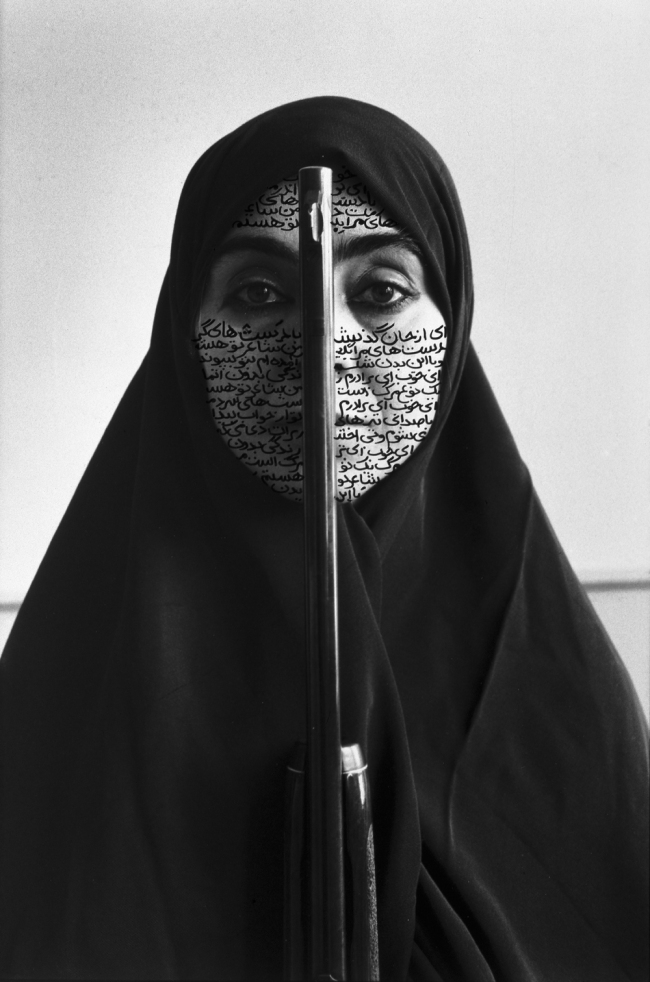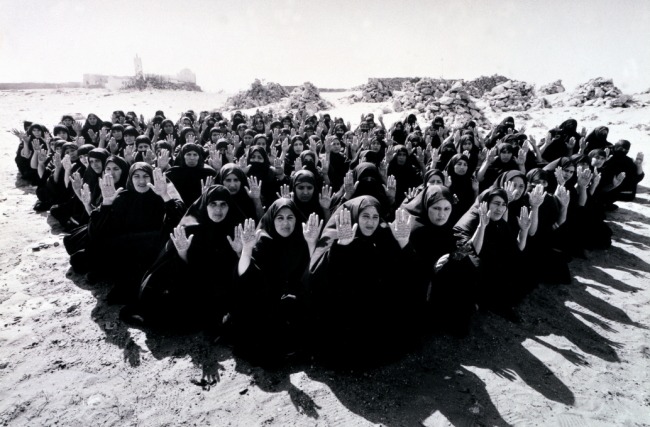Delivering voices of Iranian women
Media artist Shirin Neshat’s 20 years of work on show
By Lee Woo-youngPublished : April 2, 2014 - 20:22
Iranian-born artist Shirin Neshat has lived most of her life outside of her home country. She left Iran to study in the U.S. at age 17 in 1974 but hasn’t gone back for nearly 16 years. On her last visit in 1999, she was detained and interrogated by Iranian officials who mistook her for a political dissident.
Outside her native country, Neshat has gained an international reputation as an Iranian artist. Her inspiring TED talk on her life as an Iranian woman and artist in exile drew more than 480,000 clicks. Probably anyone who has never heard of her name might have seen a photograph of a Muslim woman whose face is covered in black Farsi script.
It is one of her works from her 20-year career on display at the National Museum of Modern and Contemporary Art, Korea. The exhibition is the first installment of the museum’s Asia Project, a series of showcases that highlight Asian contemporary artists’ works.
The exhibition shows her photograph series and films that the artist calls “embodiment of Iranian identity.” Works on display are two popular photograph series “Women of Allah (1993-1997)” and “The Book of Kings (2012),” as well as four series of films.
Generally art of today stays away from politics, but her works don’t. Through photographs, she lifts her voice on the rights of Iranian women, resistance to political and social constraints.
“My work is always navigating between issues that I face as one woman, one Iranian, one artist ― and issues that are far larger than me,” she once said about her work.
Neshat’s early photographic series “Women of Allah” explores the marginalized rights of Iranian women after the Iranian Revolution in 1979. Before the revolution, Iranian women could choose to wear hijabs, but afterwards were required to wear a veil and be segregated from men in public places.
Outside her native country, Neshat has gained an international reputation as an Iranian artist. Her inspiring TED talk on her life as an Iranian woman and artist in exile drew more than 480,000 clicks. Probably anyone who has never heard of her name might have seen a photograph of a Muslim woman whose face is covered in black Farsi script.
It is one of her works from her 20-year career on display at the National Museum of Modern and Contemporary Art, Korea. The exhibition is the first installment of the museum’s Asia Project, a series of showcases that highlight Asian contemporary artists’ works.
The exhibition shows her photograph series and films that the artist calls “embodiment of Iranian identity.” Works on display are two popular photograph series “Women of Allah (1993-1997)” and “The Book of Kings (2012),” as well as four series of films.
Generally art of today stays away from politics, but her works don’t. Through photographs, she lifts her voice on the rights of Iranian women, resistance to political and social constraints.
“My work is always navigating between issues that I face as one woman, one Iranian, one artist ― and issues that are far larger than me,” she once said about her work.
Neshat’s early photographic series “Women of Allah” explores the marginalized rights of Iranian women after the Iranian Revolution in 1979. Before the revolution, Iranian women could choose to wear hijabs, but afterwards were required to wear a veil and be segregated from men in public places.

The photographs portray veiled Iranian women staring intently at the camera and holding a gun. On their faces the artist wrote verses borrowed from works of women writers in black or red ink. The Farsi calligraphy on the women’s faces may look decorative, but they represent the unspoken voices of Iranian women scholars and writers whose works are not widely read.
Her recent photo series “The Book of Kings” is a collection of portraits which represent three groups of characters ― the masses, the patriots and the villains ― from the ancient epic poem Shahnama. Instead of inscribing verses from the poem, she featured the works of contemporary Iranian writers and letters of political prisoners.
Neshat also explores restrictions on women in Iranian society through film.
The 2009 “Women without Men,” an adaptation of a novel by Iranian writer Shahrnush, tells a tale of three female characters in the 1950s ― an aspiring political activist, a would-be mother and a prostitute. Both the film and Shahrnush’s novel are banned in Iran for revealing women’s sexuality and discontent with the Iranian society. the tales of the three characters are each played on a separate screen in a dark room.
Neshat further makes women in her films break through conventional constraints.
In “Turbulent,” she lets a woman sing in an empty theater. Iranian women are not allowed to sing in public. On the opposite end, visitors can hear a man sing a traditional Iranian song in front of a male audience.

Neshat creates other contrasting scenes of Iranian men and women in different acts. In “Rapture,” dozens of Iranian women behave unusually, such as making vibrating sounds and running to the sea, as a group of Iranian men stare surprisingly at them.
“Women without Men” won the Silver Lion for Best Director at the 66th Venice Film Festival in 2009. She also won the award at the 46th Venice Biennale with “Turbulent” and “Rapture” in 1999.
The artist said the work reflects her personal viewpoints.
“My work is very personal, really has to do with the point of view of an artist living outside of her country. I’m not a representative of the Iranian society, but they are my personal points of view,” she said via Skype from New York during a press conference of her exhibition on Tuesday at the MMCA, Seoul.
The exhibition continues through July 13 at the Seoul branch of the National Museum of Modern and Contemporary Art, Korea. For more information, call (02) 3701-9500 or visit www.mmca.go.kr.
By Lee Woo-young (wylee@heraldcorp.com)


![[AtoZ into Korean mind] Humor in Korea: Navigating the line between what's funny and not](http://res.heraldm.com/phpwas/restmb_idxmake.php?idx=644&simg=/content/image/2024/04/22/20240422050642_0.jpg&u=)


![[Herald Interview] Why Toss invited hackers to penetrate its system](http://res.heraldm.com/phpwas/restmb_idxmake.php?idx=644&simg=/content/image/2024/04/22/20240422050569_0.jpg&u=20240422150649)
![[Graphic News] 77% of young Koreans still financially dependent](http://res.heraldm.com/phpwas/restmb_idxmake.php?idx=644&simg=/content/image/2024/04/22/20240422050762_0.gif&u=)
![[Exclusive] Korean military set to ban iPhones over 'security' concerns](http://res.heraldm.com/phpwas/restmb_idxmake.php?idx=644&simg=/content/image/2024/04/23/20240423050599_0.jpg&u=20240423183955)






![[Exclusive] Korean military to ban iPhones over security issues](http://res.heraldm.com/phpwas/restmb_idxmake.php?idx=652&simg=/content/image/2024/04/23/20240423050599_0.jpg&u=20240423183955)



![[Today’s K-pop] Ateez confirms US tour details](http://res.heraldm.com/phpwas/restmb_idxmake.php?idx=642&simg=/content/image/2024/04/23/20240423050700_0.jpg&u=)